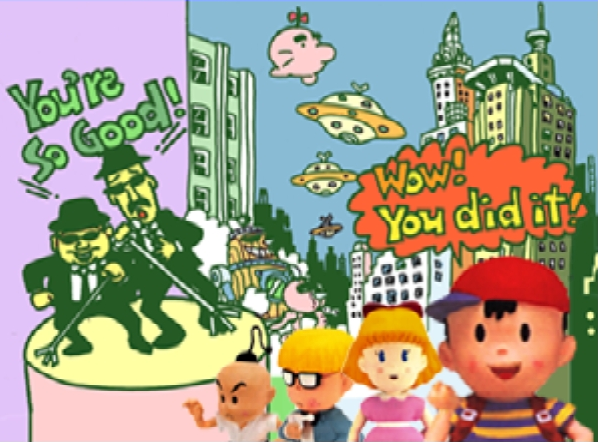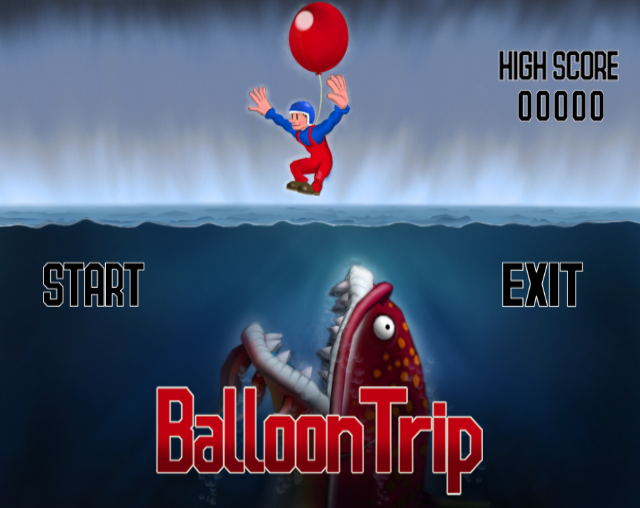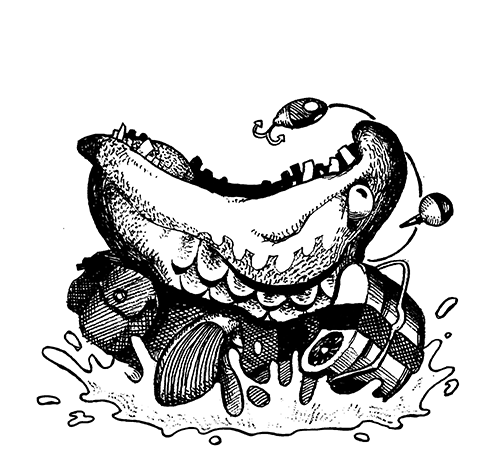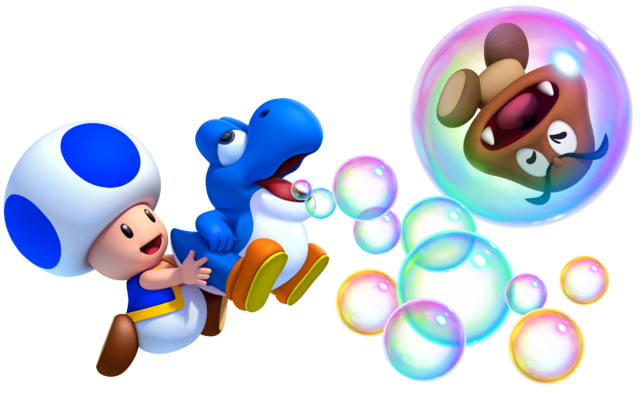|
|
Post by Nester the Lark on Aug 20, 2020 9:30:51 GMT -5
It's not too unusual for Nintendo games and series to reference each other (we have this entire section of the forum dedicated to that), but it's a lot less common for Nintendo games to make overt pop culture references. However, I was able to think of four examples, and I was wondering if you guys might know of any more. And just to make a distinction, I'm talking about specific references, and not simply things being influenced by what's popular at the time (like, for example, the similarities of the Metroid series to the Alien movies, the Katina level in Star Fox 64 resembling the climax of the movie Independence Day, or Link in Ocarina of Time supposedly being based on Leonardo DiCaprio). Here are the examples I came up with: Tokyo Mirage Sessions #FE - The character Barry Goodman is an otaku who was previously a guitarist in an American heavy metal band called Gigadeth. This is a very loose reference to Marty Friedman, former guitarist of the band Megadeth, who has been living in Japan since 2003. Xenoblade Chronicles - I've mentioned this on Twitter, but there's an achievement in the game called "Truly Outrageous," which you earn for equipping gems in all eight possible slots on a single character. This seems to be a really random reference to the '80s cartoon series Jem and its theme song " Truly Outrageous." I'm curious to know if this is the same in the Japanese version, but I feel like it might've been something Nintendo of Europe added on their own. (Was Jem popular in the UK?) The Legend of Zelda: Twilight Princess - There's a bartender and member of The Resistance in Hyrule Castle Town named Telma, and she has a cat named Louise. Telma and Louise seem to be a reference to the title characters in the 1991 film Thelma & Louise. Kid Icarus - There's a type of enemy named Phil that circles around another enemy named Collin. It seems to be a reference to singer/songwriter Phil Collins. Fry actually made a thread that pointed this out back in 2011. Can you guys think of any more? |
|
|
|
Post by Spud on Aug 20, 2020 10:39:50 GMT -5
Off the top of my head Mario 64There's a star in Cool, Cool Mountain called Slip Slidin' Away, the title a Simon & Garfunkle songIn Rainbow Ride There's a star named "Somewhere Over The Rainbow" titled after the song from The Wizard of OzMother 2 / EarthboundLucky and Nice of the Runaway Five are expies of Jake and Eliot Blues, the SNL characters played by John Belushi and Dan Aykroyd. Their designs are changed in Earthbound, but they appear in some of Ness's Super Smash Brothers art and it's uncanny.  There's also a handful of references to The Beatles, most notable of which is one set of default names for the heroes is John (Ness), Yoko (Paula), Paul (Jeff), George (Poo), and Ringo (King) |
|
|
|
Post by nocturnal YL on Aug 20, 2020 11:32:54 GMT -5
Tokyo Mirage Sessions ♯FE is supposedly full of general cultural references, but I don't know if those are specific enough. Right off the bat I can think of Kuen Tarachino, whose name is a play on Quentin Tarantino. And then we have Kirby. Oh, where do we even start… | Element | Origin |
|---|
| Mariel | 9th Angel Matarael (Neon Genesis Evangelion) | | Spark-i (Rami in the Japanese version) | Fifth Angel Ramiel (Neon Genesis Evangelion); besides the name, both also have electric power | | Graphic effects of Pon & Con in Kirby's Dream Land 3 and Kirby Star Allies | Red Kitsune (Con) and Green Tanuki (Pon), cup noodles by Toyo Suisan of the Maruchan brand fame | | Title of Goldon & Silvox (The Metal Heavies in the English version) | Kinkakuji (Golden Pavilion) and Ginkakuji (Silver Pavilion) temples | | Pause screen description of Goldon & Silvox | Kemono Friends | | Apolo | Apollo (Meiji's chocolate candy) |
And then there's the Psychopath skill in Super Mario RPG.
|
|
|
|
Post by Nester the Lark on Aug 20, 2020 20:50:25 GMT -5
Maybe there's more of these kinds of references than I realize. When I see stuff like this in a Nintendo game, I tend to think that it's unusual and un-Nintendo like. (Although, NoA has gained a little bit of a negative reputation in the past several years for occasionally putting memes into their localizations. I do not count those as pop culture references, by the way.) Also, nice to see you around again, Spud!  |
|
|
|
Post by Da Robot on Aug 25, 2020 9:38:50 GMT -5
  From Warioware: Smooth Moves and Splatoon 2's Salmon Run mode "Maws" Salmonid boss respectively appear to reference the movie Jaws. |
|
|
|
Post by Evie ❤✿ on Aug 31, 2020 14:23:27 GMT -5
Ah, nice thread! I remember posting a thread like this specific to one series. ^^ fryguy64.proboards.com/thread/4537/legendary-starfy-series-culture-references
I think Pokémon may have a reference to Gypsy Juggler ; Game Freak were really into arcade games in their early years; even originating as a handwritten arcade magazine by Satoshi Tajiri called Game Freak, and this is the Japanese name for the Juggler Trainer class (ジプシージャグラー). Gypsy Juggler (as "Gipsy Juggler" for some reason) is mentioned in Game Freak magazine Vol. 1 too. Maybe the entire Trainer class is a nod to it.


Ah, and there are others in the Pokémon franchise in general like to the "Over 9000" meme (Pokémon X/Y) and "Hi Skitty" (Omega Ruby/Alpha Sapphire).. Bulbapedia has a list. bulbapedia.bulbagarden.net/wiki/List_of_references_to_popular_culture_in_Pok%C3%A9mon
Pokémon has more too in specific localisations. www.youtube.com/watch?v=yheM8RqvqFQ
Also lavacutcontent.com/ken-sugimori-nintendo-dream-4/

This is apparently a reference to a 1980s comedy called Airplane! according to LavaCutContent.
Tokyo Mirage Sessions ♯FE is supposedly full of general cultural references, but I don't know if those are specific enough. Right off the bat I can think of Kuen Tarachino, whose name is a play on Quentin Tarantino. And then we have Kirby. Oh, where do we even start… | Element | Origin |
|---|
| Mariel | 9th Angel Matarael (Neon Genesis Evangelion) | | Spark-i (Rami in the Japanese version) | Fifth Angel Ramiel (Neon Genesis Evangelion); besides the name, both also have electric power | | Graphic effects of Pon & Con in Kirby's Dream Land 3 and Kirby Star Allies | Red Kitsune (Con) and Green Tanuki (Pon), cup noodles by Toyo Suisan of the Maruchan brand fame | | Title of Goldon & Silvox (The Metal Heavies in the English version) | Kinkakuji (Golden Pavilion) and Ginkakuji (Silver Pavilion) temples | | Pause screen description of Goldon & Silvox | Kemono Friends | | Apolo | Apollo (Meiji's chocolate candy) |
And then there's the Psychopath skill in Super Mario RPG.
Incidentally some Nintendo games have interesting backgrounds, like Balloon Kid and The Legendary Starfy series. In particular, I've wondered about these.

Who/what actually are they?
Another thing is often games reference Japanese culture (e.g. Tomodachi Life in Japan, Starfy) but not necessarily multimedia.
The "suspicious characters" and certain mystery elements in The Legend of Zelda: Link's Awakening were inspired by Twin Peaks, apparently. www.nintendo.co.uk/Iwata-Asks/Iwata-Asks-The-Legend-of-Zelda-Spirit-Tracks/Iwata-Asks-Zelda-Handheld-History-/3-Make-All-Characters-Suspicious-Types/3-Make-All-Characters-Suspicious-Types-233845.html
|
|
|
|
Post by Evie ❤✿ on Oct 24, 2023 23:51:24 GMT -5
Some more Pokémon ones:
1. Abra, Kadabra, Alakazam's names are from the magical incantations popular in stage magic, "abracadabra" and "alakazam"; of course for most of us that may be obvious.
2. The Japanese names of the Pokémon line in 1. are based on specific illusionists/magicians/psychics;
ケーシィ (Casey) is from Edgar Cayce. He was known for putting himself into a hypnotic trance-like state, and the Pokémon Abra is known for excessive sleeping (sleeping 18 hours a day).
ユンゲラー (Yungerer) is infamously from Uri Geller (known for apparently bending spoons with his mind, like Kadabra's spoon with the move Kinesis (スプーンまげ Spoon Bend)). In November 2000 Geller sued Nintendo for £60 million for using his likeness without permission and Kadabra cards were not printed in the Trading Card Game since 2003. However, Geller would eventually dismiss the lawsuit on Twitter on November 28, 2020, so since June 16, 2023 (Japanese Pokémon Card 151 subset) cards have been printed again.
フーディン (Foodin) is from Harry Houdini, an illusionist and escape artist.
3. In Generation I, the television in Pallet Town in the English version references "four boys walking on railroad tracks" and may be a reference to the film Stand by Me. In Generation III and VII this is only if the player is a male, instead if the player is female it references a "girl in pigtails walking down a yellow brick road" and may be a reference to the film The Wizard of Oz.
4. In the French versions of Generation I, the TV instead alludes to Dragon Ball ("a little boy with a monkey tail" according to Twitter user reggie_800, a reference to Son Goku) because Julien Bardakoff really liked it (according to DidYouKnowGaming). All other localisations allude to Stand by Me.
5. In the French version, an NPC in Fuchsia City Gym also includes a reference to Space Sheriff Gavan (a Japanese show popular in France at the time) "I wanna be a ninja and jump from tree to tree, like on TV like X-HOG the space pig".
6. Also the French names of Articuno, Zapdos, Moltres Artikodin, Électhor, Sulfura are based on the Nordic Gods Odin and Thor and the Egyptian Sun God Ra respectively. Beedrill's French name Dardargnan references The Three Musketeers. Gyarados's (Leviator) references Leviathan.
7. This did not remain in the final games, though during the localisation of Generation I, English translator Nob Ogasawara originally nicknamed an NPC's Spearow "Britney"; after American singer and celebrity Britney Spears but Nintendo changed it to Speary and warned Nob not to do it again or there would be an instant termination.
8. In the Japanese versions of Generation I, on the sixth floor of Silph Co. a scientist references a supposed branch from "Ponaya Tunguska" (ポナヤツングスカ) which seems to be a reference to the Russian Podkamennaya Tunguska river. In the English version it was changed to Tiski (a reference to the city in Russia) to reduce space.
These two are also more real-world references than pop-culture references but I felt like including them anyway (9. is also from tcrf.net/Pok%C3%A9mon_Red_and_Blue/Translation_Errors)
9. The July 5 Cinnabar Mansion diary mentions "Guyana, South America". In the German versions it was changed to "Dschungel tief im Niemandsland." ("Jungle, deep in no man's land."). The French versions call it "Jungle X" and the Tiksi mention is replaced with "Trifouilli" (a fake town name "in the middle of nowhere!") but unintentionally there still is a real-world reference to Russia where a Saffron City Gym trainer says "Tu va en baver comme un russe" (a French saying).
10. The Japanese version of Red and the English versions of Yellow and Stadium (and later games) call Arcanine a legendary Pokémon in China admired for its beauty (this might be true in other language versions too). I wonder however if this is some cultural reference.
(More real-world references bulbapedia.bulbagarden.net/wiki/Pok%C3%A9mon_world_in_relation_to_the_real_world )
On that note, two more from that page which count as cultural (although older) I found interesting:
11. Hitmonchan and Hitmonlee are derived from martial artists Bruce Lee and Jackie Chan. The Japanese name for Hitmonchan エビワラー (Ebiwalar) is derived from Japanese boxer 海老原博幸 (Hiroyuki Ebihara).
The Japanese name for Hitmonlee Sawamular (サワムラー ) is from famous kickboxer Tadashi Sawamura (沢村忠). The Korean name for Hitmonlee 시라소몬 from 시라소니 (Sirasoni) a nickname of famous Korean street knight 이성순 Yi Sung-sun combined with monster.
12. The Japanese name of Hitmontop カポエラー (Kapoerer) is a reference to an Afro-Brazilian cultural practice called Capoeira; both a dance and a fight also regarded as an art form, and the poses/movements are similar to Hitmontop's.
13. These two are just speculative (so you can ignore them), but in Pokémon Yellow there are unused in-game trades for Mew for Mew and Pidgeot for Pidgeot. The English localisation calls the received Mew BART and the received Pidgeot MARTY. A friend of mine thought Mew could be based off Bartholomew the Apostle. At one point I also wondered if it was inspired by Bart Simpson because Mew's backsprite is 'bumped' or 'spiky' like Bart's hair (and its front sprite exclusive to Japanese Red/Green). On hindsight my idea sounds silly now, although on the other hand there is a Simpsons character called Marty.
More from Bulbapedia bulbapedia.bulbagarden.net/wiki/List_of_references_to_popular_culture_in_Pok%C3%A9mon
|
|
|
|
Post by Nester the Lark on Oct 25, 2023 8:20:15 GMT -5
It's interesting to know the references in other languages, and if/how they were localized into different languages. (It's not a pop culture reference, but like how the pop idols from Splatoon all have different names in every language to maintain the aquatic puns and references.)
|
|












